Rabat’s status as a locus of national power and history is palpable, from the 12th century seaside Kasbah of the Oudayas, to the diplomats you’re likely to overhear lunching at the city’s fine French eateries today.
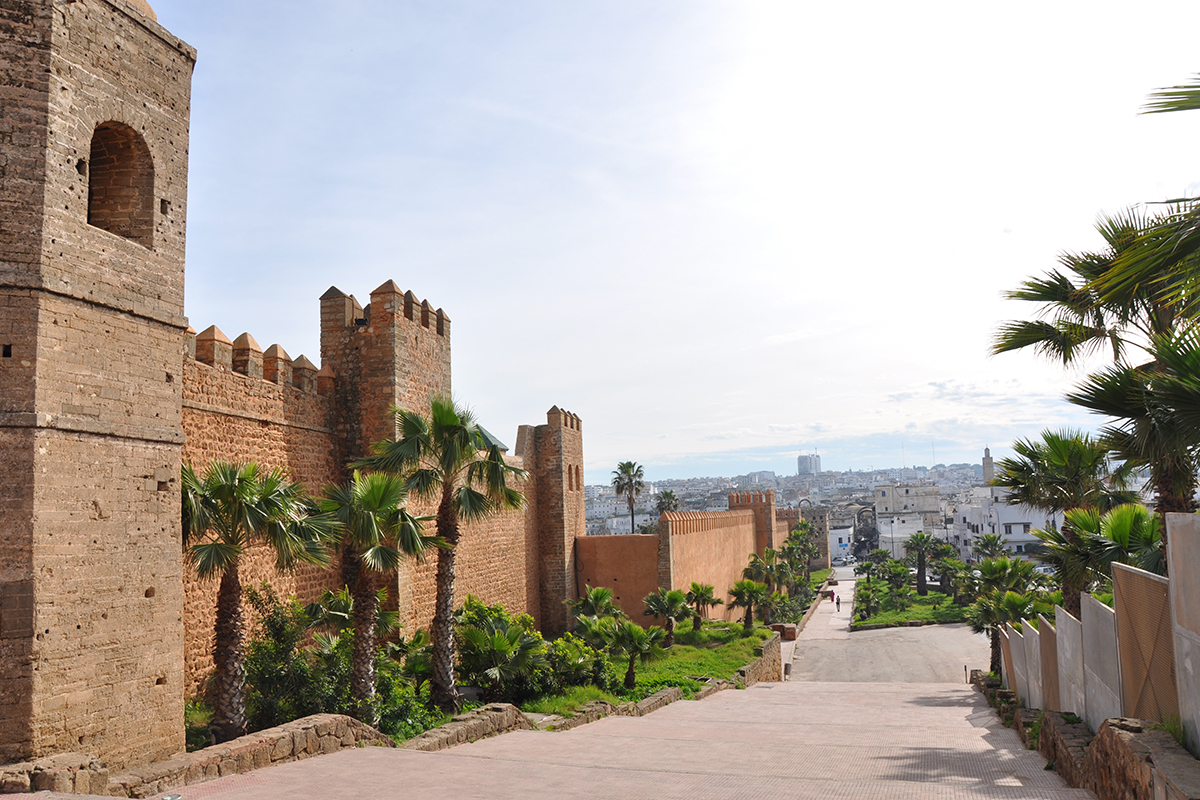
Walls of Rabat’s Kasbah of the Oudayas (Photo: Jorge Láscar via Flickr / CC BY 2.0)
Attractions of the Medina
Rabat became Morocco’s capital during the French colonial protectorate, established in 1912, though the city dates back centuries. Its medina, an old, walled neighborhood of tightly packed houses and winding passageways, evokes a sense of Rabat’s antiquity, although the imperial cities of Fez, Meknes and Marrakech overshadow Rabat in terms of historical significance. Instead, both Rabat and its neighbor Salé were bastions of extrajudicial activity, notorious for harboring pirates well into the 19th century.
Present-day Rabat has a patchwork of well-preserved ancient monuments and traditional architecture attesting to different chapters of its lengthy and complex history. Additionally, the fact that the city’s economy is less reliant on tourism means that the atmosphere at sightseeing locations is generally more relaxed than those of Fez or Marrakech.
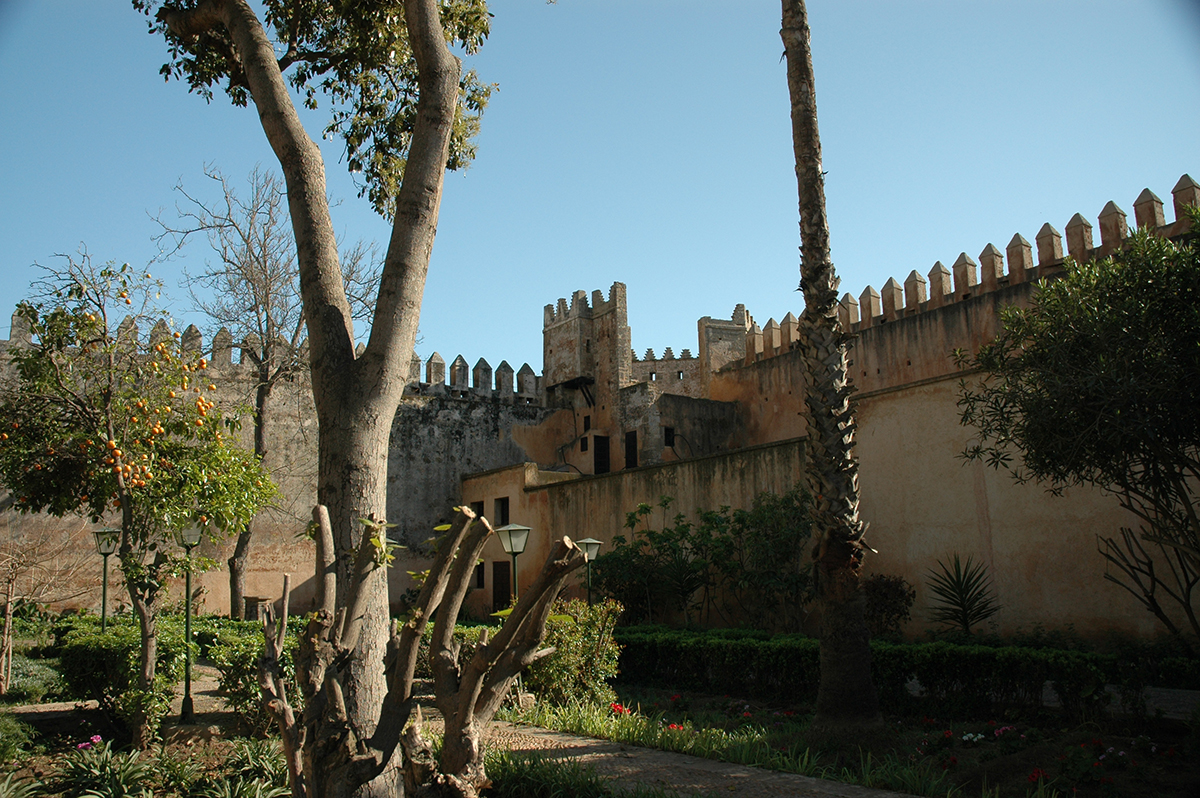
Inside Rabat’s Andalusian Garden (Photo: Shawn Allen via Flickr / CC BY 2.0)
With the Atlantic Ocean to the west and the Bouregreg River to the north, Rabat’s historic architecture reflects the influence of its geography. The blue-walled Oudayas Kasbah, or citadel, faces the Atlantic and the kasbah’s foundations date back centuries to the Almohad Caliphate. Situated within the kasbah is the Andalusian Garden, a lush courtyard of flowering plants, fruit-bearing trees, and palms, created by the French in the 20th century. A side exit from the garden feeds into a small, tiled terrace café, where visitors can sip mint tea with views towards Salé across the Bouregreg.
Attractions of the Ville Nouvelle
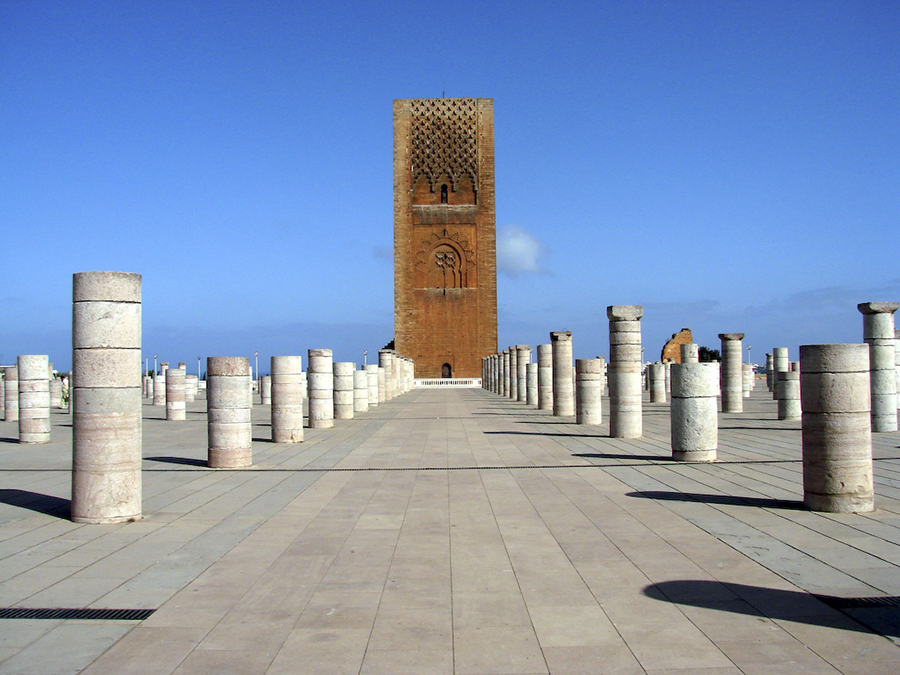
The Hassan Tower minaret (Photo: Hicham M. Hamdaoui via Flickr / CC BY-SA 2.0)
Rabat’s Ville Nouvelle (or new city) offers its own sense of place and list of attractions. Its tree-lined boulevards are clearly French in conception, as are many of the Art Deco buildings that line them. Mixed in alongside the French colonial vestiges are grand monuments from Morocco’s history. The Hassan Tower is all that remains of a mosque dating to 1195 and the Almohad Caliphate. Formerly a minaret, the tower resembles other architectural remnants from Morocco’s Almohad period, such as the Koutoubia Mosque in Marrakech and the Tin Mal Mosque in the Atlas Mountains.
In general, however, the farther you venture from the medina, the progressively newer the architecture becomes. The posh modern neighborhood of Agdal is a short ride by taxi or aboard the tramway from Rabat’s centre ville, or downtown. With its range of shops, restaurants, and cafés, Agdal has established itself as a bustling commercial neighborhood with a strong expat contingent.
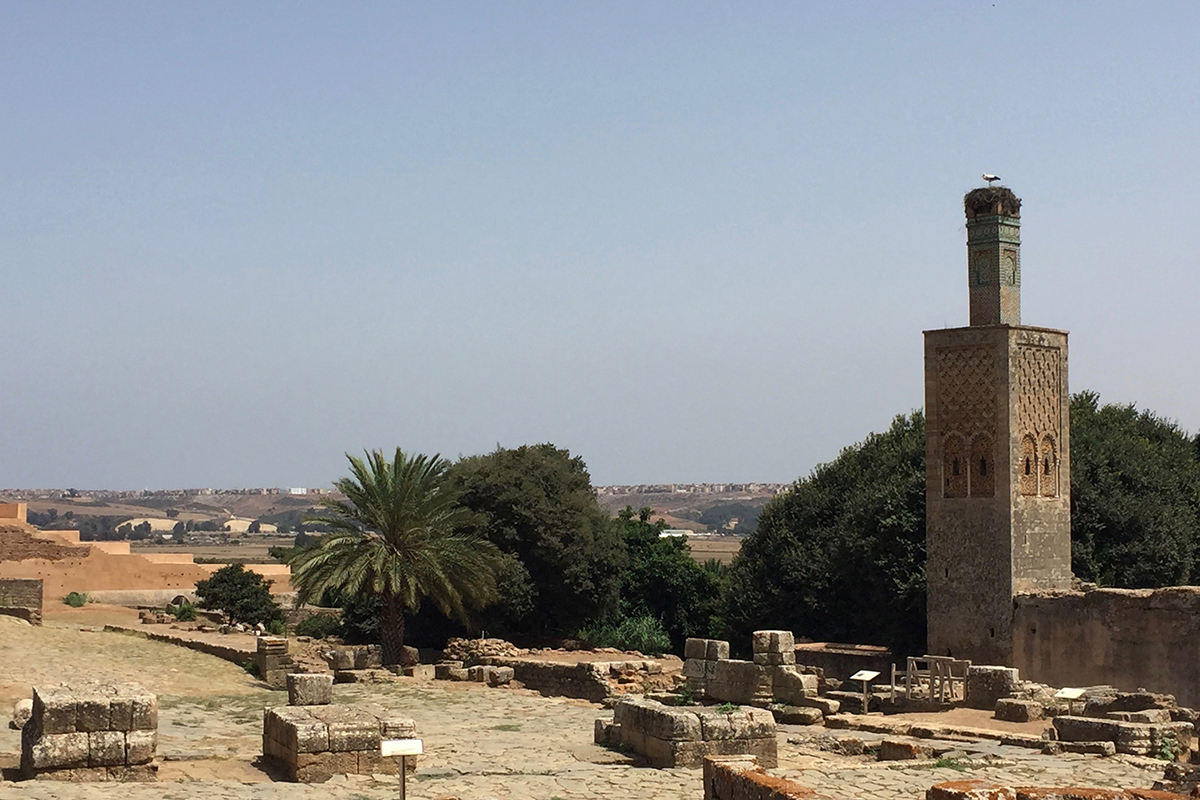
Stork roosting in the minaret of Rabat’s Chellah ruins (Photo: Sarah Goodman for TravelMag.com)
Chellah is a striking hillside ruin that dates back to the Roman era. Many layers of Morocco’s past are embedded in Chellah’s history: “Sala Colonia,” as it was then called, was a thriving port connecting the Roman Empire with its inland outpost of Volubilis, a site in the agriculturally fertile Fez-Meknes region. Chellah was later appropriated as a tomb for Almohad monarchs.
Museums and Art Galleries
As the capital of Morocco, Rabat is the site of a number of the nation’s principal museums. The small but impressive Museum of History and Civilizations is an archaeology museum not far from the city’s downtown. The museum attests to chapters of Morocco’s pre-Islamic and early Islamic history. Many of its highlights, like the collection of Roman-era bronzes, were harvested from the Roman outpost of Volubilis roughly 175 kilometers inland.
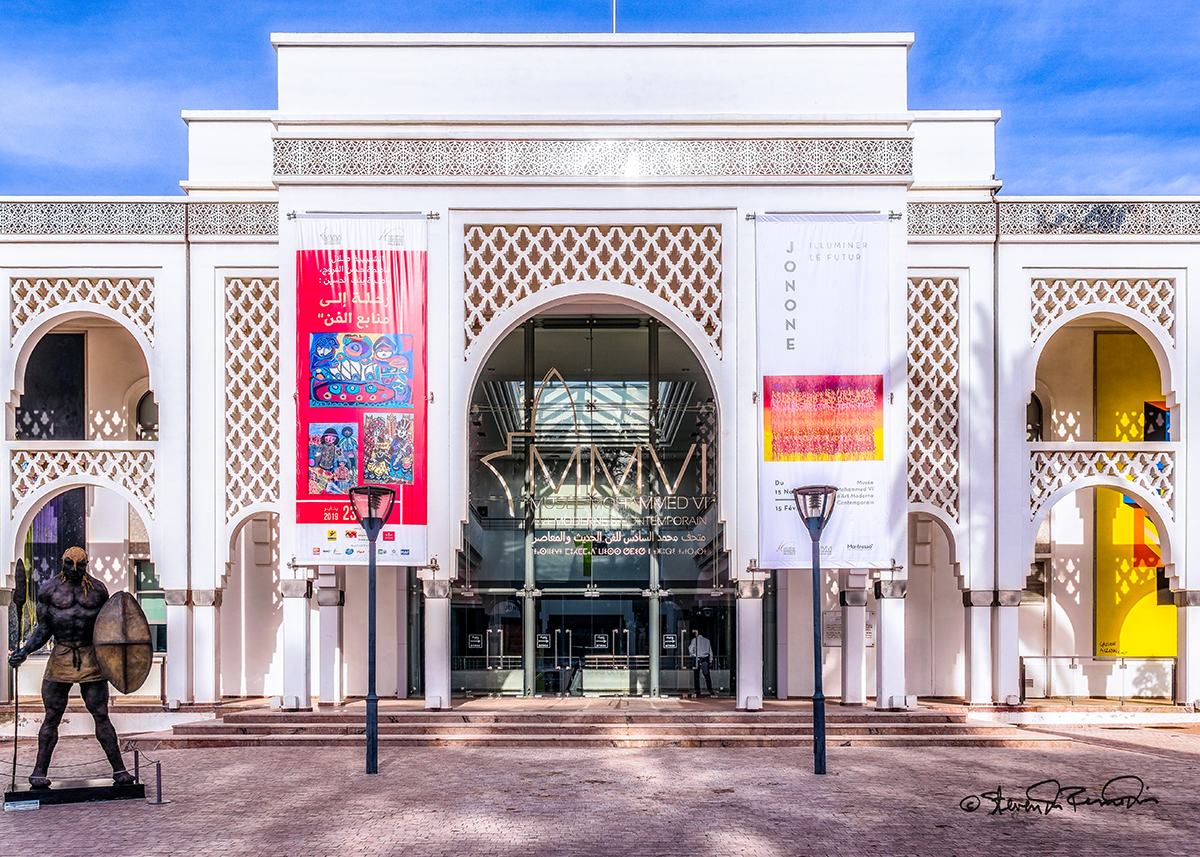
Mohammed VI Museum of Modern and Contemporary Art (Photo: Steven dos Remedios via Flickr / CC BY-ND 2.0)
Rabat also has a vibrant contemporary art scene. The Mohammed VI Museum of Modern and Contemporary Art, founded in 2014, is an expansive, neo-Moorish building visible from the Rabat Ville train station. In addition to its permanent collection of Moroccan and pan-African artists, the museum has mounted recent temporary exhibits ranging in subject from Picasso to French Impressionism.
Rabat also hosts a number of art galleries, most within a five-minute radius of the museum. The Kulte Gallery, located just around the corner, has an impressive bookstore and café as well as exhibition space. Both Le Cube and L’Appartement 22 are independent galleries with a focus on African and North African artists. L’Espace Expressions CDG, set into the Pietri Square, and Villa Des Arts both have rotating exhibitions of photography, painting, and design.
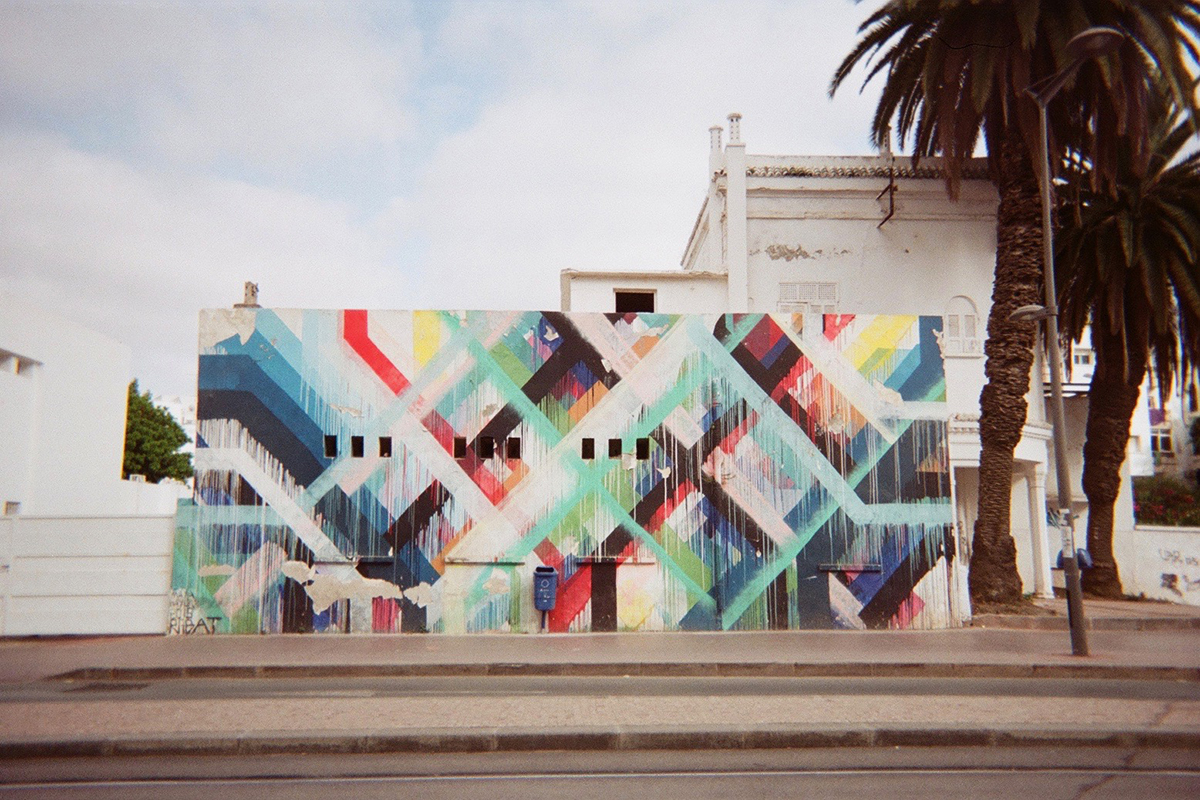
Rabat Ville Nouvelle (Photo: Sarah Goodman for TravelMag.com)
Arabic, French, and Amazigh Languages
Morocco is a multilingual country. There are three officially-recognized languages, written forms of which are visible on government buildings, public schools, and public transit. The first is Modern Standard Arabic (MSA), a mostly-written language distinct from the local Moroccan-Arabic dialect, Darija. Recent debate has called into question Darija’s status as a ‘dialect’ and whether it might qualify as a language in its own right. French still retains currency as an administrative language, an enduring residue of the colonial period. Morocco’s indigenous Amazigh, or Berber, people have their own languages, the alphabet for which, Tifinagh, became officially recognized and adopted in Morocco in 2003.
Transportation:
Bordered on two sides by water, Rabat sprawls to the south and east, making transportation a consideration for anyone hoping to explore the capital’s different neighborhoods. As with any Moroccan city, Rabat’s streets have the ubiquitous petit taxis. (Taxis are different colors depending on the city; Rabat’s petit taxis are dark blue.) Unlike many other cities, Rabat has a Tramway with multiple lines to accommodate the city’s many commuters.
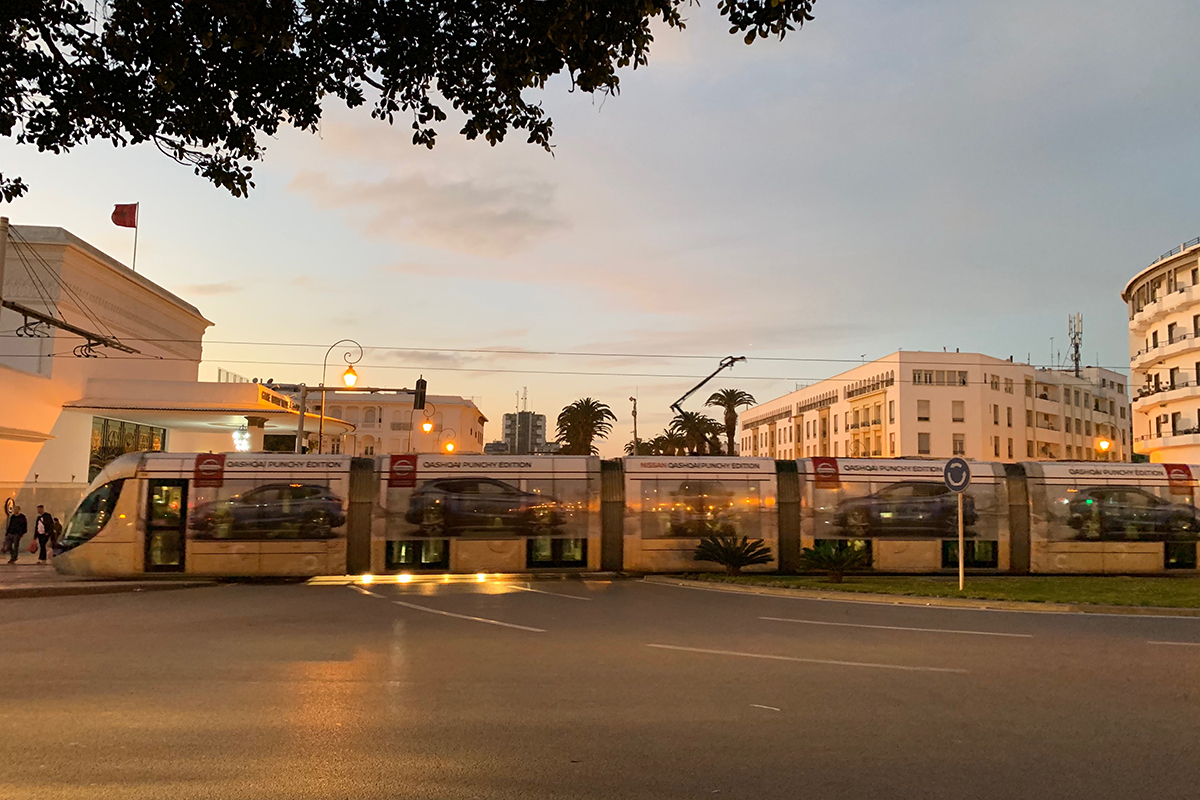
Rabat’s tramway passes the Rabat Ville train station (Photo: Sarah Goodman for TravelMag.com)
For traveling between cities, the Moroccan National Train Service, the ONCF, offers intercity rail services. Rabat has two train stations, Rabat Ville and Rabat Agdal. The former is located in the city’s historic downtown, the latter in the newer neighborhood of Agdal. Ticket pricing varies: tickets are more expensive during peak hours and booking in advance will usually save you some money and time in last-minute queues.
For destinations not accessible via the ONCF, there are a number of Moroccan buses you can take. Both CTM and SupraTour are reliable bus services with agencies in Rabat’s industrial Kamra district.
A Quick Note on Petit Taxis
Taxi drivers will seat up to three people in a taxi; if you’re a party of four or more, you’ll have to split up. Be aware that taxi drivers will sometimes pick up multiple riders going in the same direction. The taxi meter can track multiple separate rides, but taxi drivers are obliged by law to start the meter afresh for each passenger. Always politely ask for the meter to be turned on upon entering a taxi, so that the cost of your ride isn’t arbitrarily determined. A “merci” or “shukran” can go a long way in this regard.
Hotels & Accommodation
The Smarts Hotel (35 rue Azegza) has a modern, minimalist design and is in the heart of the bustling Rabat neighborhood of Agdal. Located a short distance from one of Rabat’s two train stations, the hotel caters to both business and leisure travelers. Rooms range from singles to suites. The Smarts Hotel is also an easy walk from Avenue de France, one of Agdal’s commercial thoroughfares, lined with ice cream parlors, shops, and restaurants.
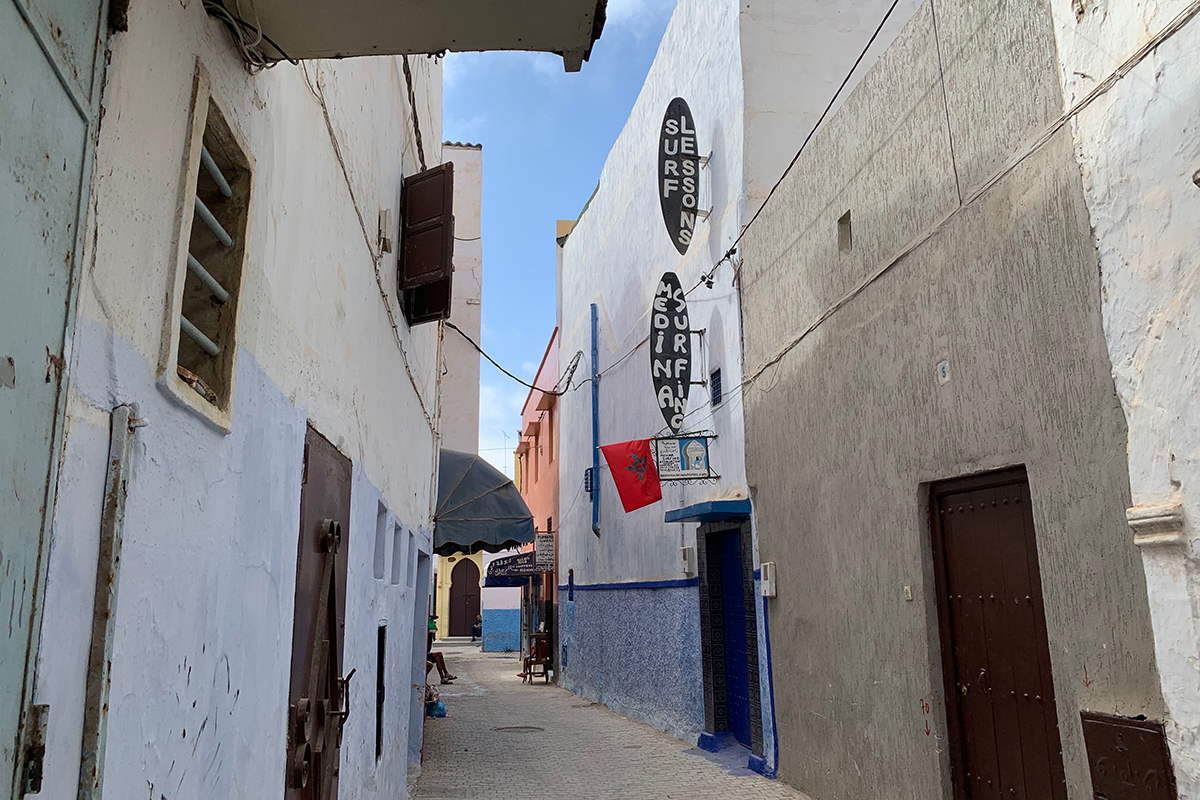
Narrow pedestrian street of the Medina Surfing Association (Photo: Sarah Goodman for TravelMag.com)
As the name suggests, the Medina Surfing Association (3, rue Porte Maoune Farran Znaki) is a short walk into Rabat’s old city, or medina, and a short walk from the Atlantic. Originally established to promote cultural exchange between surfers, the adjoining hostel is open to all, surfers and landlubbers alike. The hostel has a relaxed atmosphere, mixing traditional decor with assorted surfing-themed posters and paraphernalia. Both shared and private rooms are available, and breakfast is included in any booking. Two-hour surfing classes for a range of levels are available at an additional cost, including surf boards and necessary gear. Located a three-minute walk from the automobile-accessible Rue de Consules.
Tour Hassan Palace (26 avenue Chellah) is named for — and within sight of — Rabat’s ancient Hassan Tower, a minaret dating back to the 12th century. Though not as ancient, dating from the early 20th century, it is one of Rabat’s foremost luxury hotels. Expect professional and highly-personalized service. With a lush courtyard, Hotel Tour Hassan offers visitors the chance to sip a poolside juice or cocktail. Among the facilities available are a spa and sizable conference rooms.
Within walking distance of the Rabat Ville train station, Hotel Belere (33 avenue Moulay Youssef) is in the heart of Rabat’s downtown. Hotel Belere’s chicly eccentric 1960s exterior pairs nicely with the building’s mid-century modern furnishings. Facilities available include free WiFi, meeting rooms, and airport — and beach — shuttles. The location also is a five-minute walk from Rabat’s flagship Mohammed VI Museum of Modern and Contemporary Art.
Couscous
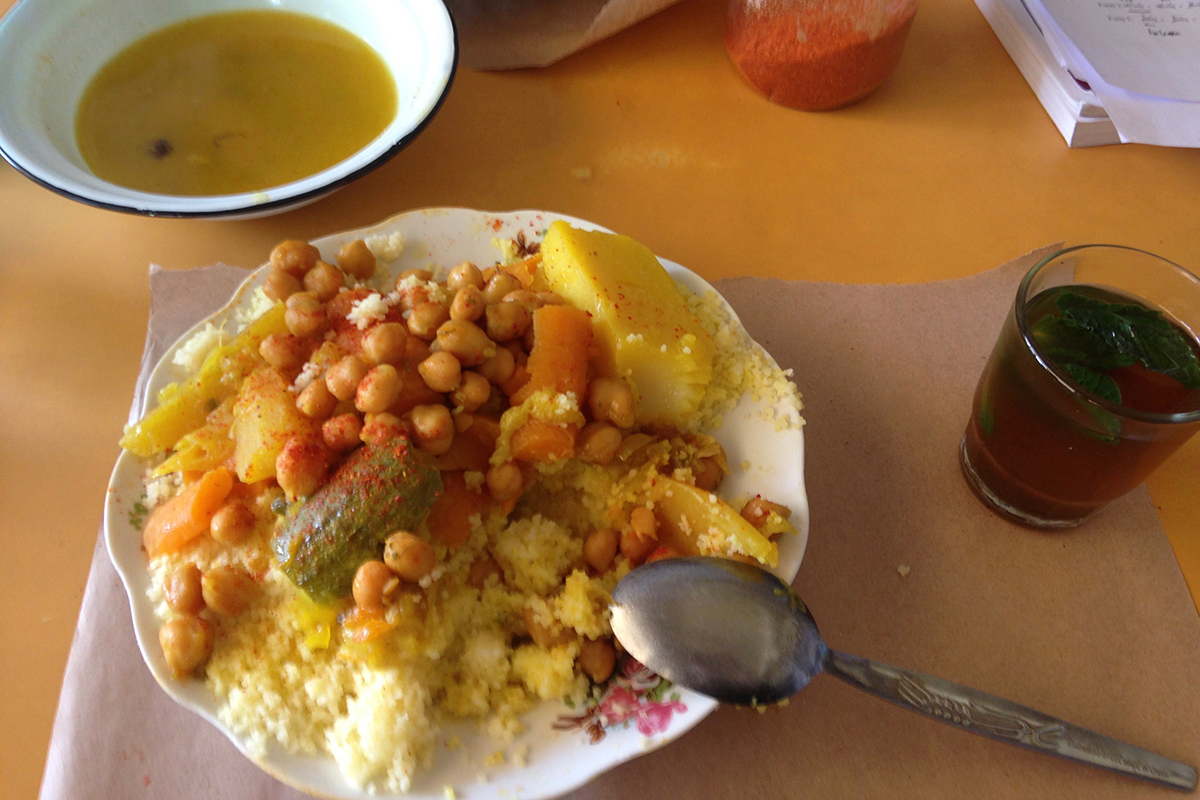
Friday vegetable couscous with mint tea, sauce on the side (Photo: Sarah Goodman for TravelMag.com)
Couscous is a staple of North African cooking. The dish refers to the crushed and fluffed semolina grain, typically served with stewed meats and vegetables. Ingredients and preparation vary regionally. Tunisian couscous tends to use more fish-based stews while Moroccans often use lamb or chicken. Moroccan couscous is also unique in that it’s mostly prepared on Fridays, traditionally enjoyed as a family meal after Friday afternoon prayers at the mosque. Many restaurants in Rabat will prepare couscous on Fridays, even if it’s not advertised on the menu.
Restaurants & Bars
Deciding where to eat tajine (referring to a traditional clay pot used to cook meats and vegetables) can be difficult given its abundance and affordability. Dar Naji (rue Jazirat Al Arab) is famed in Rabat for traditional Moroccan cuisine. Combinations like lamb and prune or chicken and lemon are served in the piping hot tajine itself and eaten with a wheel of bread, used to soak up the juices. Dar Naji is also known for rfissa, a traditional dish of chicken, lentils, and onions served on a nest of shredded flatbread. Moroccan mint tea is poured with arms at full extension, such that the liquid arcs perfectly into the teacup, a technique which both aerates the tea and allows the server to demonstrate his or her marksmanship.
For a high-end dinner, take a seat at Le Georges (5 rue Oued Baht), a contemporary bistro in Agdal. The menu features a fresh take on French cuisine and offers a range of traditional Moroccan dishes available as specials. Live jazz music and an extensive wine list make Le Georges a lively place on weekends, popular with locals, expats, and travelers.
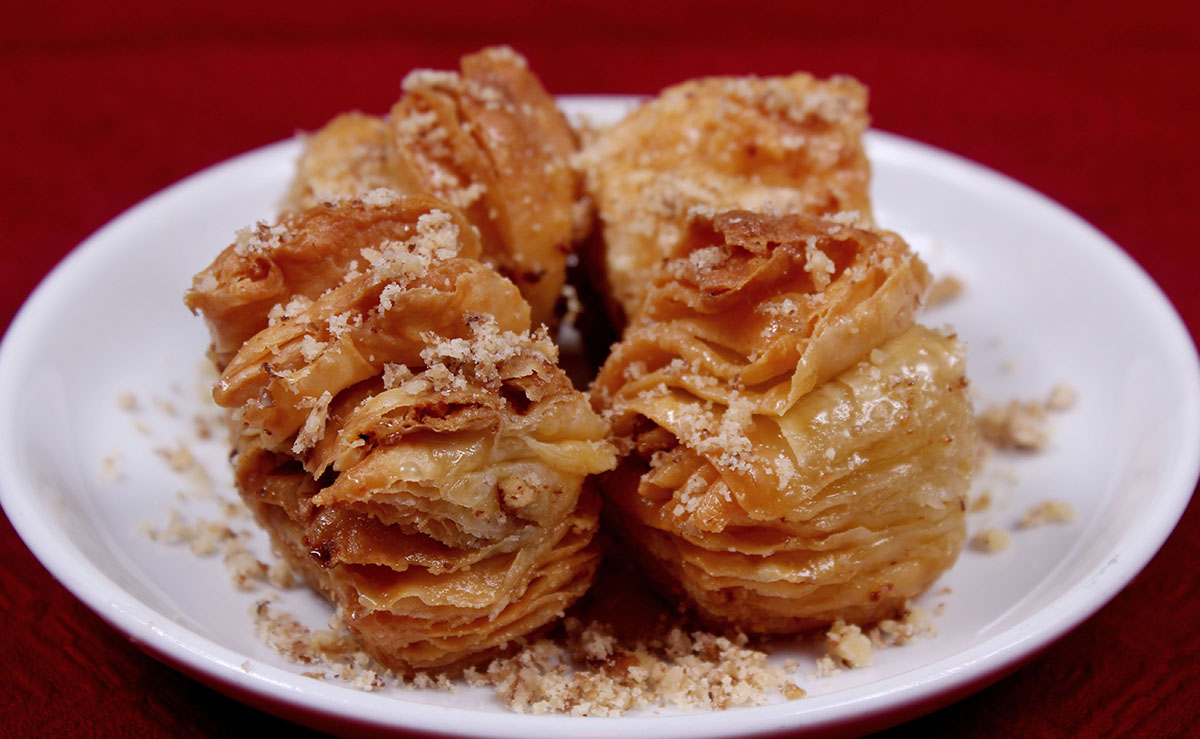
Syrian desserts from Yamal Acham (Photo: Courtesy of Yamal Acham)
You won’t find tajine or couscous on the menu of Yamal Acham (5 avenue Al Maghrib Al Arabi). This Syrian-run restaurant has become a local institution, as popular with Moroccans as it is with tourists. Yamal Acham first opened near Rabat’s medina and recently expanded to a second location, with outdoor seating, in the Agdal neighborhood. There are classic dishes like homous, taboulé, falafel and meat chawarma, or thinly-shaved meat. In addition, Yamal Acham offers a host of vegetarian dishes like mtabal of either beet or eggplant purée, fatteh served warm with chickpeas and tahini, and warak enab, a Syrian variation of stuffed grape leaves. The restaurant also serves decadent, honey-soaked desserts to top off the meal or for take-away.
Le Petit Beur (8 rue Damas), around the corner from the Rabat Ville train station, serves a variety of North African fare. (‘Beur’ is French slang for Arab.) The blue and white mosaic walls of the single-story interior create an intimate space in which to enjoy the meal. Rotating daily specials include delicacies like Moroccan pastella (a filo-wrapped sweet and savory pie, typically served with cinnamon, chicken, almonds, and a dusting of sugar). Light, vegetarian sides like taktouka (tomato, peppers, onion) and zaalouk (a Moroccan take on eggplant caviar) are a delicious start to the meal.
SottoSopra (10 rue Al Marj) is an Italian-owned restaurant and bar, as popular for its affordable thin crust pizzas as for its Negronis. Located an easy walk downhill from the Hassan Tower, SottoSopra’s cocktail menu is one of the best in Rabat. Complimentary popcorn is served with drinks. With its loud music and spacious, dimly lit interior, SottoSopra has carved out a reputation for itself as a Rabat afterhours destination.
Bookstores
Morocco has a wealth of bookstores sprinkled across the city. Growing interest in learning English means that many more Arabic and Francophone book sellers have begun to stock Anglophone writers as well. Rabat’s English Bookshop (4 Rue Al Yamama), the capital’s first English-only bookstore, stands alone for its collection of used and new titles. Store proprietor Mohammed Belhaj opened in 1985, hoping to help other Moroccans meet the demand for English reading material. Belhaj continues to run his store in much the same way since that time: nothing is digitized and all the bookshop’s inventories, pricing, and receipts are done by hand. In addition to a range of classic English-language texts from Shakespeare to Toni Morrison, the store also has a robust selection of critical theory including works by post-colonial thinkers like Edward Said and Franz Fanon. All the books, however diverse in genre and provenance, have the English Bookstore logo carefully stamped on the front pages.
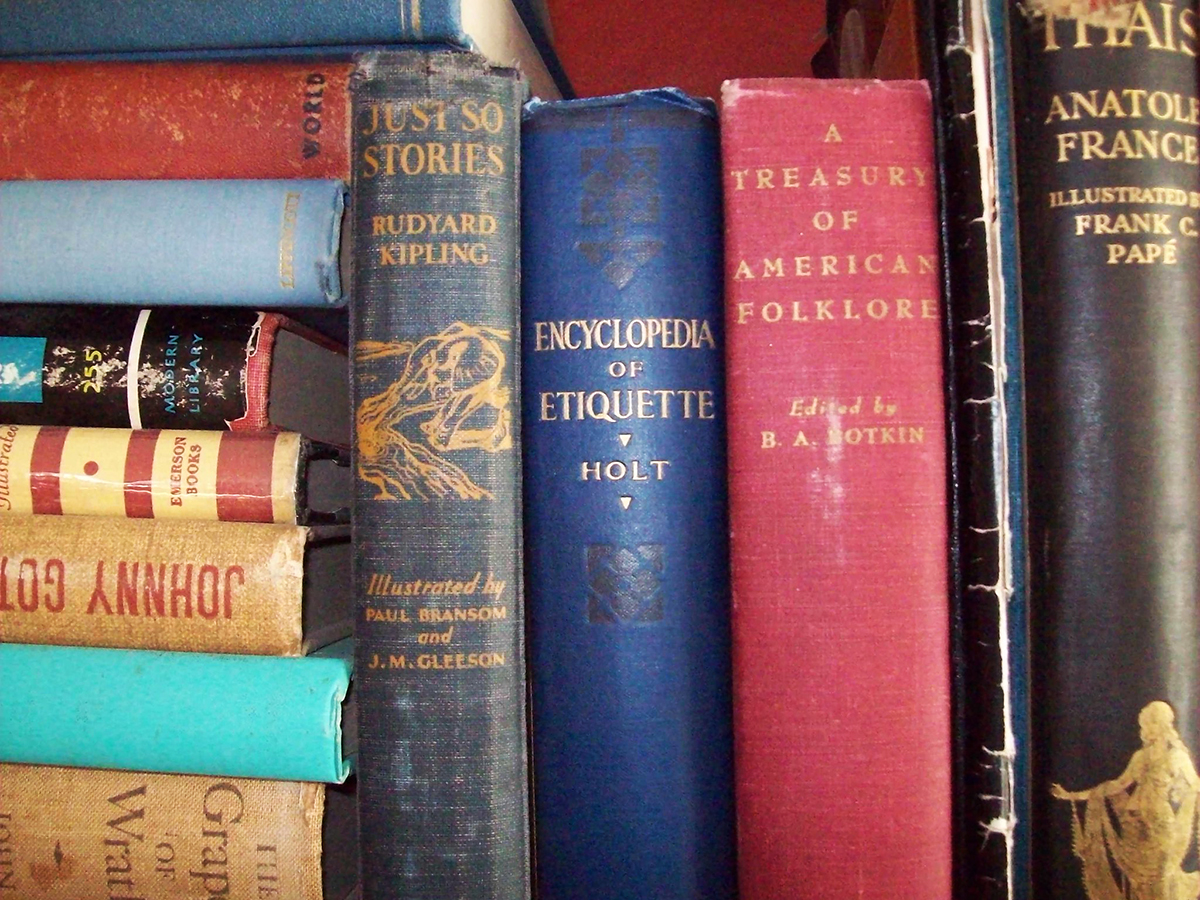
Second-hand books for sale (Photo: amidfallenleaves via Flickr / CCO 1.0)
Located between Moroccan Parliament and the walls of Rabat’s Medina, bookstore Kalila wa Dimna (344 avenue Mohammed V), named after a famous historical text, is a fixture of the local community and is famed for its selection of multilingual books. From grammar textbooks to contemporary literature to children’s books, the bookstore has a wide range available. Though the majority is in French, they stock enough titles to keep readers of English, Spanish, and Arabic perusing the shelves. Most of the English-language books are new, but they sell some used editions as well, and have a range of postcards, stationary, and maps on offer as well.
Although Rabat’s chic Kulte Gallery & Editions (7 rue Benzerte) is primarily known for its art exhibitions, the adjoining bookstore is equally reputed. Kulte publishes its own titles in Arabic, English, and French with a particular focus on North Africa and the Middle East. In addition, the polyvalent space has a café on site, where you can sit and thumb through specially printed exhibition catalogues and contemporary art books.
Librairie Populaire (4 rue Ghazzah) is a small unassuming storefront in downtown Rabat offering a wide range of English-language classics. In addition to the bookstore’s selection of French and Arabic texts, there are several shelves with an impressive selection of the Penguin Little Black Classics series. Most of the inventory are new editions of texts from Anglophone writers, although Librairie Populaire also stocks a number of English translations of works from the wider literary canon, such as Kafka, Stendhal, and Tolstoy.